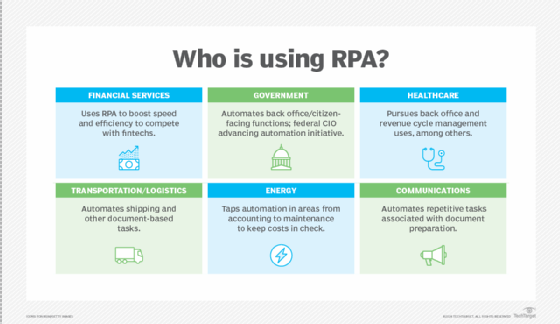
What are the advantages and disadvantages of RPA?
While RPA offers several benefits in the enterprise, there are also a few drawbacks. According to experts, these are the top eight pros and five cons of RPA for organizations to consider.
As PSCU, a credit union service organization based in St. Petersburg, Fla., focused on growth in recent years, the company saw robotic process automation as one of the tools that could help it scale. Therefore, it developed a strategic RPA plan, choosing Nice for its automation software and consulting capabilities.
PSCU, which implemented its first bot in September 2019, now has RPA handling four back-office functions, said Molly Walker, the company's manager of business excellence running its RPA center of excellence.
The company currently has "a long list of use cases in the pipeline," Walker said, adding that the technology is not only helping PSCU keep up with its growth, but is delivering other benefits as well.
It's clear that automation is becoming a mainstay at organizations across industries. Gartner predicted that 90% of large organizations globally will adopt RPA in some form by 2022 and will triple the capacity of their existing RPA portfolios through 2024.
Business leaders and business advisors said the benefits RPA delivers are driving that growth. However, they also said there are potential disadvantages to using RPA, particularly when organizations are not thoughtful or strategic about the automation projects they undertake.
Those leaders shared the following list of the advantages and disadvantages of RPA for CIOs and other IT leaders to consider.
8 advantages of RPA
1. Efficiency gains. RPA can complete tasks more quickly than humans, and it's able to do so at a lower cost. As a result, organizations can expect productivity boosts without seeing a commensurate increase in costs that would have occurred had they hired new workers to do the same volume of work within the same allotment of time.
"That's just how bots operate -- it's computer code, so it runs 365 [days,] 24/7, unlike us humans who need to take breaks. It's tough to compete with," said Tony Abel, managing director of the supply chain solutions practice and RPA lead at the consulting firm Protiviti.
2. Reduction in errors. "Computers do what they're told. They don't make a lot of errors as humans can sometimes do," Abel said, adding that RPA software also provides a comprehensive audit trail so organizations can see what was done when.

3. Increased agility. RPA often enables an organization to more easily accommodate business process changes, said Ken Weilerstein, analyst and consultant at The Analyst Syndicate.
Workers can often make quick adjustments within the RPA software, which tends to be lightweight and flexible, rather than request IT staffers carve out time and resources to revise the underlying business systems -- typically, a more time-consuming, complex and costly task.
Similarly, because RPA is layered on top of enterprise systems and not built into them, new RPA deployments or changes to existing bots come with a lower risk of disruption or unintended consequences. Therefore, organizations have the option to use RPA to enable rapid adjustments to processes, further increasing their agility.
4. Better use of people power. RPA often enables organizations to shift workers' attention from low-value tasks to higher-value ones that deliver better customer experience and ultimately support revenue growth, according IT advisors and management leaders.
Walker saw that shift in her own company, saying: "RPA helps us scale by freeing up our employees to do value-add work." For example, customer service representatives once spent a significant amount of time gathering and keying data for rate change requests. This limited the time they had to directly engage with customers in consultative conversations. But, now, RPA bots handle that gathering and keying work, Walker said, giving workers more time to engage directly with customers about how PSCU services could meet their needs.
Simply put, RPA lets workers spend more time on advisory tasks instead of copying and pasting.
5. Increased employee engagement. Because RPA bots handle the repetitive, and sometimes mundane, tasks within the enterprise, employees can shift more of their time to more valuable work, which, in turn, often makes for more engaged employees, Abel said.
6. Improved customer satisfaction. According to Abel, customers can also benefit from organizations automating processes, as the automation can create a faster and better experience. A bot, for example, can access and retrieve information to answer a customer's request in real time so that there's no need to ask the customer to hold.
7. Standardization of processes. Even when organizations optimize their processes, they can rarely ensure that the human employees follow the prescribed steps every time in every single office location, said Kevin Martelon, a process consultant and automation partnership manager at Saggezza, a global IT consultancy.
Sometimes, individual employees in different locations tweak the process to their own liking. RPA, on the other hand, performs its tasks exactly as it's programmed to do, ensuring that a process is followed consistently every time across locations.
8. Business continuity support. Organizations can use RPA to help support their business continuity (BC) plans by building bots that can take on tasks typically handled by outsourced services in the event those services are knocked offline, according to Martelon.
"RPA can act as a backstop; it's like buying a generator," he said, noting that, even if the bots aren't called into action, their presence can help organizations meet BC objectives as required by regulations or their insurance policies.
5 disadvantages of RPA
1. Attrition. Although RPA bots don't always displace workers, it is a possibility. Moreover, because organizations can add bots to handle increasing workloads, they won't need to hire the additional workers who would have otherwise handled that growing volume of work.
"Vendors push that RPA eliminates work that's boring and redundant, but in reality, there were people who earned their money doing that work. So, there is work being eliminated and jobs and hours that are being cut," Weilerstein said. "It's a real worry for people, and it's also a question of optics for business."
2. Sprawling technology. As organizations add more bots to perform more tasks, they risk creating an unwieldy collection that becomes more difficult and more costly to manage and maintain.
"That can happen if you're not governing it right, if understanding who has responsibility for what isn't formalized [and] if you're just building bots and throwing them into production," Abel said, stressing the need for effective governance and an effective RPA center of excellence to avoid such scenarios.
3. Added complexity. Similarly, RPA can create layers upon layers of software when it's not effectively documented, managed and governed, Weilerstein said. It creates complexity that could make business improvements harder to achieve.
"RPA makes it easy for businesses to cope with changing business processes, and that makes it easy for them to do it piecemeal rather than updating the software in a systematic way. The problem with that is, if something goes wrong, it makes it difficult to troubleshoot to find out what went wrong," Weilerstein said. "It's having all the layers that makes the entire picture more complicated."
4. Magnification of problematic processes. According to experts, organizations that don't first review and, if necessary, reengineer and optimize processes before automating them risk automating problematic processes. This means amplifying inefficiencies, errors and anything else that was wrong with the process in the first place. It also adds costs, which could negate any expected ROI, and introduce new risks.
5. Thwarted transformation. Executives who see RPA as a tactical point-by-point offering rather than a tool that's part of a holistic strategy will get more limited benefits, according to Martelon. Enterprise leaders who want RPA to support their digitization objectives must have a strategic plan for prioritizing their automation projects and understand how those projects fit into their overarching strategic visions.







